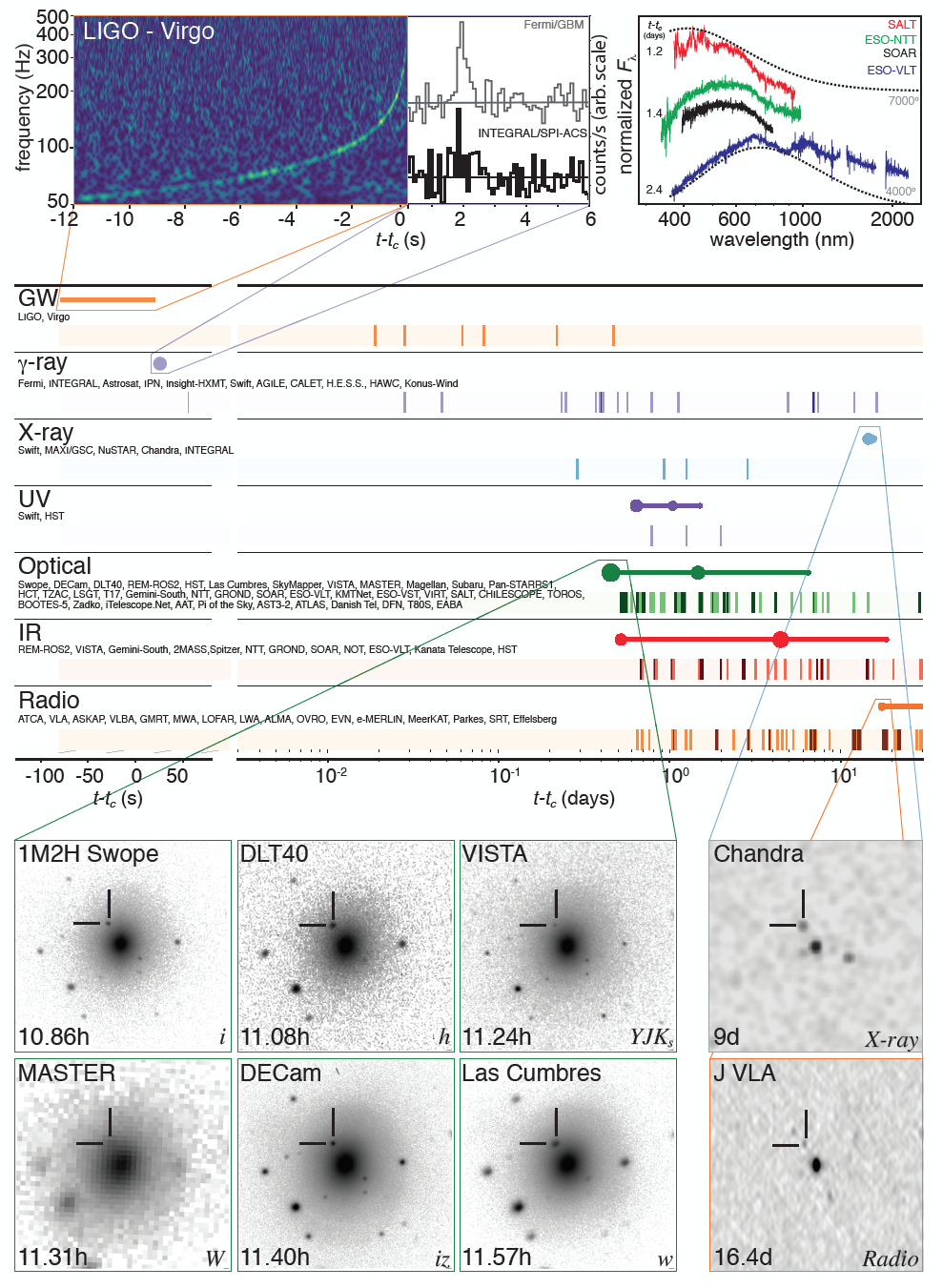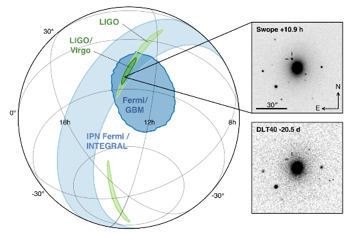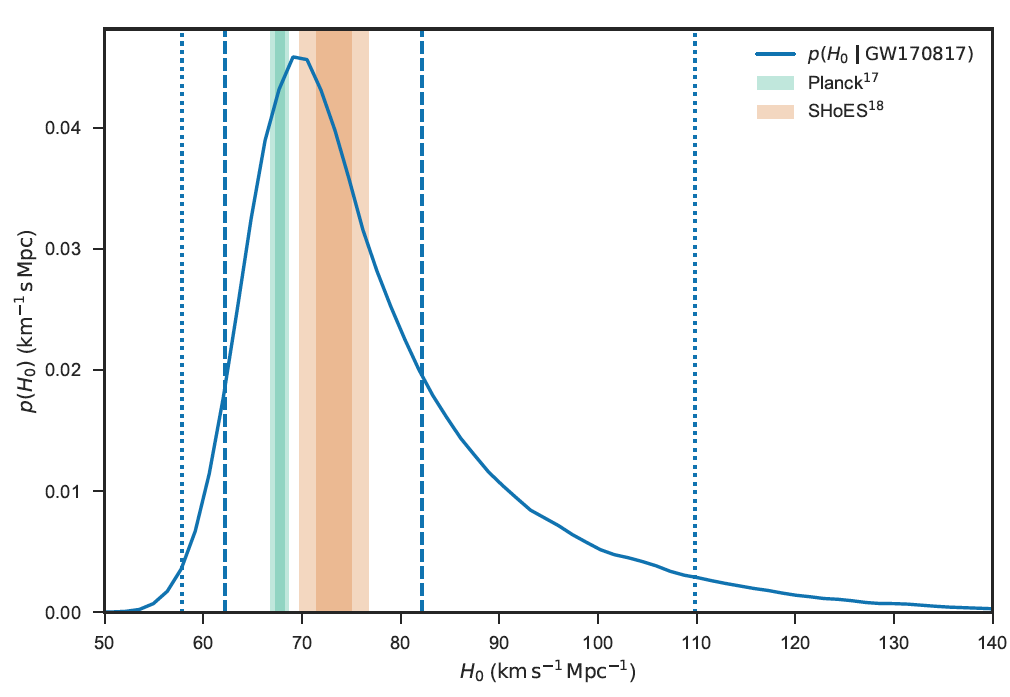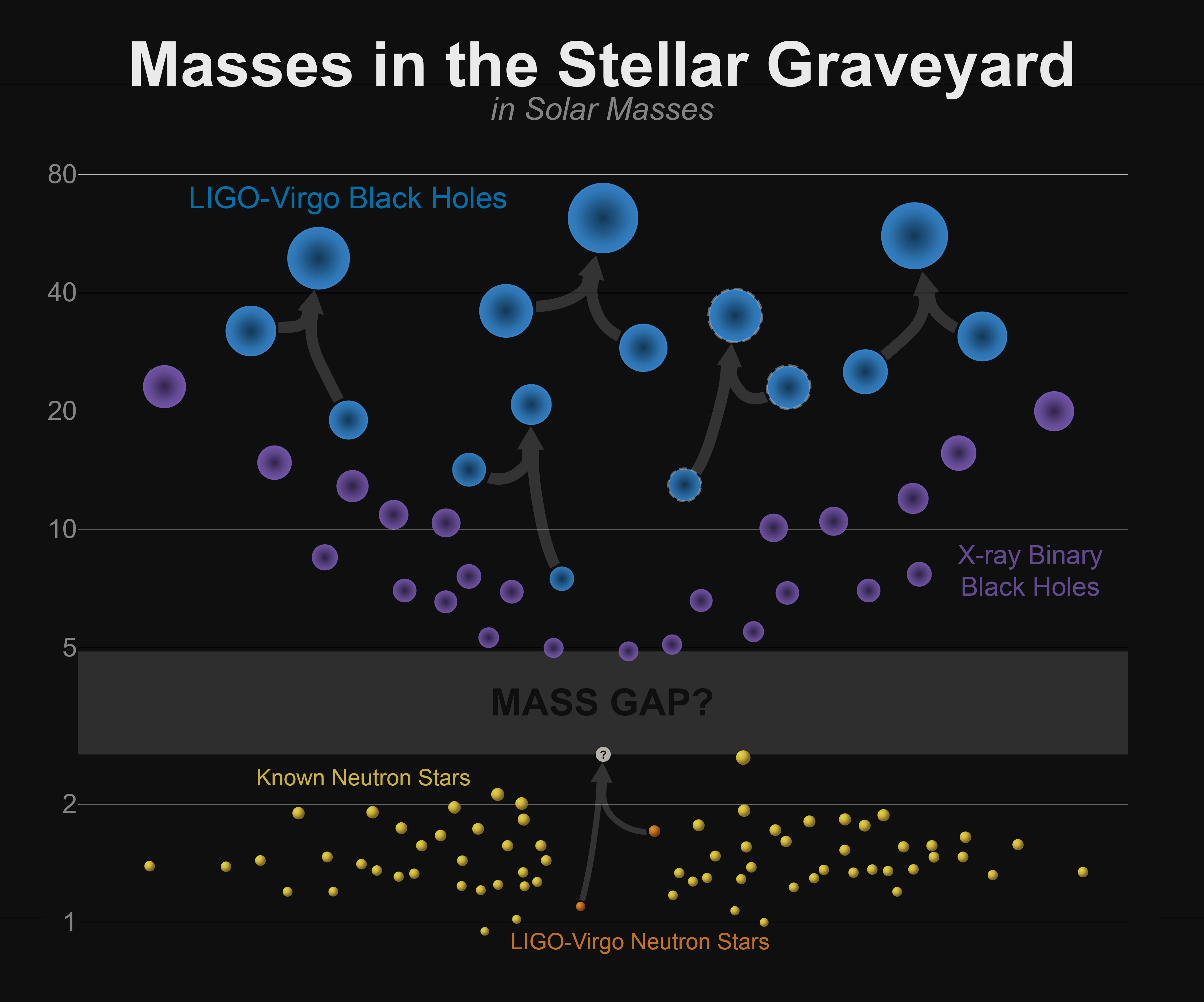The LIGO-Virgo collaboration, together with astronomers from 70 observatories, today announced the observation of the fusion of two neutron stars in the gravitational and electromagnetic ranges: they saw a gamma-ray burst, as well as X-ray, ultraviolet, visible, infrared and radio radiation.
 Illustration of neutron star collision. A narrow discharge on the diagonal - the flow of gamma rays. The luminous cloud around the stars is the source of visible light that was observed by telescopes after fusion. Credit: NSF / LIGO / Sonoma State University / Aurore SimonnetNeutron stars
Illustration of neutron star collision. A narrow discharge on the diagonal - the flow of gamma rays. The luminous cloud around the stars is the source of visible light that was observed by telescopes after fusion. Credit: NSF / LIGO / Sonoma State University / Aurore SimonnetNeutron stars , the smallest and densest of all stars, are formed by a supernova explosion. When two neutron stars form in a pair, they rotate around each other, and gradually lose energy, moving closer and radiating gravitational waves, until they finally collide. Such a collision was observed by the LIGO telescopes, and two seconds after - the gamma-raying reached
the Fermi space telescope , and in the following days and weeks astronomers could observe the event in other electromagnetic ranges.
For the first time, gravitational waves were
recorded two years ago - from the confluence of black holes. Since then,
three more
signals from black holes have been taken by detectors, the
last one just three days before this event.
Under the cut - about the signal and discoveries associated with it: an accurate estimate of the speed of gravitational waves, an independent estimate of the Hubble constant and new data on the physics of neutron stars.
UPD A summary of the main article on detection of GW in Russian is
here .
List of scientific articles (updated links as they become available) A total of
67 articles on the discovery
were published yesterday at arXiv.
About signal
From the very beginning of LIGO, scientists were waiting for the registration of waves from collisions of neutron stars, since they are quite common in the Universe, and a pair of neutron stars were already observed using radio telescopes. For example, the
Khalsa-Taylor double pulsar discovered in 1974, where the existence of gravitational waves was indirectly proved for the first time: during 40 years of observations, two neutron stars moved closer, losing some of the rotational energy due to the emission of gravitational waves. In about 300 million years, these two neutron stars will collide, producing a signal similar to what LIGO observed this time.
The gravitational waveform, GW170817, was registered on August 17, 2017 at 8:41 am EDT. An automatic data processing program detected a strong signal on one of the LIGO detectors, and two seconds later the Fermi space telescope saw a burst of gamma radiation. Telescopes and LIGO exchange data on potential events, and on the basis of this coincidence between the signals, an alert was sent to other telescopes around the world, which began observations in different ranges. The signal was also present in the data of the second LIGO detector, but was initially not accepted by automation due to glitch (which is discussed below).
 All signals on the timeline
All signals on the timelineAnalysis of data from LIGO made it possible to estimate the parameters of the signal source - two neutron stars with masses from 1.1 to 1.6 solar and a diameter of about 20 km. Unlike previous observations of the merger of black holes, where the merger itself took milliseconds, this signal lasted about 100 seconds. The signal source was much closer than the previous ones - only about 130 million light years. As a result, the signal turned out to be much cleaner from noise — a signal-to-noise ratio of 32.4, which means that only once every 80,000 years can such a signal be accidentally produced by fluctuations of noise in the detectors.
At the time of detection, the European Virgo detector also worked on it, but there was no signal on it that helped determine the location of the source: Virgo was located in relation to the wave so that it was not sensitive to it (
there is a video illustration of the explanation). Read more about how the three detectors help to improve the source localization can be found
here .
The combined observation of the gamma-ray burst, gravitational waves and visible light made it possible to determine not only the area in the sky where the event occurred, but also the galaxy NGC 4993 to which the stars belonged.
 Determining the location of different detectors in the sky
Determining the location of different detectors in the skyWhat can we say about neutron stars?
Astronomers have observed
short bursts of gamma radiation for many decades, but did not know exactly how they arise. The main assumption was that this surge occurs as a result of the merging of neutron stars, and now the observation of gravitational waves from this event confirmed the theory.
When neutron stars collide, the main part of their substance merges into one supermassive object, emitting a “fireball” from gamma radiation (the shortest gamma-ray burst recorded two seconds after gravitational waves). After this, the so-called
kilon effect occurs when the substance remaining after the collision of neutron stars is carried away from the collision site, emitting light. Observation of the spectrum of this radiation made it possible to determine that heavy elements, such as gold, are born as a result of kilon ones. Scientists observed the post-glow for weeks after the event, collecting data on the processes that occurred in the stars, and this was the first reliable kilon observation.
Neutron stars are superdense objects formed after a supernova explosion. The pressure in the star is so high that individual atoms cannot exist, and inside the star there is a liquid "soup" of neutrons, protons and other particles. To describe a neutron star, scientists use the equation of state that relates pressure and density of a substance. There are many options for possible state equations, but scientists do not know which ones are correct, so gravitational observations can help resolve this issue. At the moment, the observed signal does not give a definite answer, but it does help to give interesting estimates on the shape of the star (which depends on the gravitational attraction to the second star).
An interesting discovery turned out that the observed short gamma-ray burst is closest to the Earth, but at the same time too dim for such a distance. Scientists have suggested several possible explanations: perhaps the gamma-ray beam was of uneven brightness, or we saw only its very edge. In any case, the question arises: previously, astronomers did not assume that such dim bursts could be so close, and could they then miss the same dim bursts, or did they incorrectly interpret them as more distant? Joint observations in the gravitational and electromagnetic ranges can help to give an answer, but at this level of sensitivity of the detectors such observations will be quite rare - on average 0.1-1.4 per year.
In addition to gravitational and electromagnetic radiation, neutron stars emit neutrino flux in the process of fusion. Neutrino detectors also worked on finding these flows from the event, but did not record anything. In general, this result was expected - as in the case of a gamma-ray burst, the event is too dim (or we are observing it from a large angle) for the detectors to see.
Gravitational wave speed
Since gravitational waves and the light signal originated from one source with a very high probability (5.3 sigma), and the first light signal came 1.7 seconds after the gravitational one, we can limit the speed of propagation of gravitational waves with very high accuracy. Assuming that light and gravity waves were emitted simultaneously, and the delay between the signals was due to the fact that gravity is faster, you can get an upper estimate. The lower estimate can be obtained from the neutron star fusion models: suppose that the light was emitted 10 seconds after the gravitational waves (at this point all processes had to be completed exactly) and caught up with the gravitational waves by the time of reaching the Earth. As a result, the speed of gravity is equal to the speed of light with great accuracy.

For a lower estimate, you can use a large delay between the radiation, and even assume that a light signal was first emitted, which will reduce the accuracy proportionally. But even in this case, the estimate is extremely accurate.
Using the same knowledge about the delay between signals, one can significantly improve the accuracy of estimates for
Lorentz invariance (differences between the behavior of gravity and light during the Lorentz transformation) and
the equivalence principle .
More details -
in the publication or summary (in English).
About the delay between signals
It should be noted that the delay between the gravitational and the gamma signal in the case of the validity of the standard theory (the speed of light and GW are exactly equal, there are no tricky modifications of GTR) can be explained by astrophysical factors. Scientists suggest several possible scenarios. The main hypothesis of the formation of gamma-ray beams is the collapse of the residue from the merging of neutron stars into one black hole, and the flow of gamma particles occurs at the moment of collapse. If after the merger of neutron stars they formed one large (unstable) neutron star, it could have existed from several seconds to minutes before the collapse in the BH, which caused a delay. Another explanation for the delay may be the need for a relativistic gamma-ray beam to pass through the gaseous envelope discharged during the fusion process. This shell may be opaque to radiation, and before the beam "breaks through" a window in it, a certain time passes. These scenarios are discussed in detail in the publication.
Hubble Permanent
 Credit: 1M2H / UC Santa Cruz and Carnegie Observatories / Ryan FoleyThe Hubble constant
Credit: 1M2H / UC Santa Cruz and Carnegie Observatories / Ryan FoleyThe Hubble constant connects the distance between two objects with the speed of their distance from each other due to the expansion of the Universe: v = H
0 * d. This is the most fundamental quantity in cosmology, which determines the size of the Universe and the basic laws of cosmology. Determining the Hubble constant is a difficult task, since measuring distances between objects is usually nontrivial.
Usually,
intergalactic distance scales (space ladder) are used to measure distances, when different measurement methods are used to measure short and long distances. Many of these methods are based on knowledge of the luminosity of objects called standard candles (for example, Cepheids or supernovae) - then, by measuring their brightness, you can calculate the distance. Thus, the Hubble constant in the
SHoES project (
Hubble telescope ) was calculated.
Scientists measured the Hubble constant and in another way - by observing the parameters of the CMB at
the Planck telescope , and obtained another value of the Hubble constant, which is not consistent with the SHoES measurements. This difference is too large to be statistical, but the reasons for the discrepancies in the estimates are not yet known. Therefore, an independent measurement is necessary.
 The probability distribution for the Hubble constant using gravity waves (blue). The dotted lines denote the intervals 1σ and 2σ (68.3% and 95.4%). For comparison, the intervals 1σ and 2σ for the previous estimates are shown: Planck (green) and SHoES (orange), which do not converge with each other.
The probability distribution for the Hubble constant using gravity waves (blue). The dotted lines denote the intervals 1σ and 2σ (68.3% and 95.4%). For comparison, the intervals 1σ and 2σ for the previous estimates are shown: Planck (green) and SHoES (orange), which do not converge with each other.Gravitational waves in this case play the role of standard candles (and are called standard sirens). Observing the amplitude of the signal on the Earth and simulating its amplitude at the source, one can estimate how much it has decreased, and thereby find out the distance to the source - regardless of any assumptions about the Hubble constant or previous measurements. Observation of the light signal made it possible to determine the galaxy, where a pair of neutron stars were located, and the removal speed of this galaxy was well known from previous measurements. The relationship between speed and distance is Hubble constant. It is important that such an estimate is completely independent of previous estimates or the cosmic distance scale.
One dimension was not enough to solve the riddle of differences in the Planck and SHoES scores, but on the whole the score is already well in line with the known values. Considering that previous estimates are based on statistics collected over many years, this is a very significant result.
The article was published in Nature (
here you can read ), and here you can find a summary (English).
A little bit about LIGO and glitches
 The top panel shows the glitch in the LIGO-Livingston data, and also clearly demonstrates the presence of a chirp. The bottom panel shows the dimensionless amplitude of the oscillations, "strain" (the magnitude with which we describe the magnitude of the signal in LIGO and Virgo) at the time of the glitch. This is a short
The top panel shows the glitch in the LIGO-Livingston data, and also clearly demonstrates the presence of a chirp. The bottom panel shows the dimensionless amplitude of the oscillations, "strain" (the magnitude with which we describe the magnitude of the signal in LIGO and Virgo) at the time of the glitch. This is a short
(lasts only about 1/4 of a second), but a very strong signal. Suppression reduces the glitch to the level of the orange curve, which indicates the level of background noise that is always present in the LIGO detectors.Only one of the LIGO detectors saw the signal in the automatic mode, since the “glitch” occurred on the detector in Livingstone at the time of the event. This term is called a burst of noise, similar to a clap of static in a radio receiver. Although the gravitational wave signal was obviously visible to the human eye, automatics cut off similar data. Therefore, it was necessary to clear the signal from the glitch before the data could be used by the detector. Glitches appear in detectors all the time - about once every few hours. Scientists classify them according to shape and duration and use this knowledge to improve detectors. You can help them with this in the
GravitySpy project, where users search and classify glitches in LIGO data to help scientists.
Unanswered Questions
 Black holes known to us, neutron stars and their fusions. There is a region of average masses, about the existence of compact objects with which we know nothing. Credit: LIGO-Virgo / Northwestern / Frank Elavsky
Black holes known to us, neutron stars and their fusions. There is a region of average masses, about the existence of compact objects with which we know nothing. Credit: LIGO-Virgo / Northwestern / Frank ElavskyWe registered gravitational waves from two compact objects, and the observation of electromagnetic radiation suggests that one of them was a neutron star. But the second could be a black hole of small mass, and although no one had seen such black holes before, they could theoretically exist. From the observation of GW170817, it is impossible to determine exactly whether this collision was between two neutron stars, although this is more likely.
The second interesting point: what was the object after the merger? He could become either a supermassive neutron star (the most massive of all known) or the easiest of all known black holes. Unfortunately, the observation data is not enough to answer this question.
Conclusion
Observing the fusion of neutron stars in all bands is a tremendously physics-rich event. The amount of data obtained by scientists during these two months alone has made it possible to prepare several dozen publications, and it will be much more when the data becomes publicly available. The physics of neutron stars are much richer and more interesting than black hole physics - we can directly check the physics of the superdense state of matter, as well as quantum mechanics under strong gravitational fields. This unique opportunity can help us finally find the connection between the general theory of relativity and quantum physics, which has eluded us so far.
This discovery once again shows how important in modern physics is the joint work of many collaborations of thousands of people.
Reddit ama
Traditionally on Reddit, scientists from LIGO answer user questions, highly recommend it!
It will happen from 18 o'clock in Moscow on October 17 and 18. The link to the event will be at the start time.
Additionally